Domenico di Paride Alfani belonged to an important Perugian family. He was first documented as an associate of Raphael: a note on the reverse of a drawing (ca. 1507, see below) that Raphael sent to him requested (among other things) that he should obtain payment on his (Raphael’s) behalf from Atalanta Baglioni, presumably for the Baglioni Altarpiece (see below). Raphael unsurprisingly had a profound influence on his artistic development.
Domenico Alfani was inscribed in the painters’ guild of Perugia in 1510. In 1520, he legitimised his sons Cesare and Orazio Alfani, whose mother he married 1536.
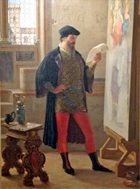
Perugia
Baglioni Altarpiece (1507)
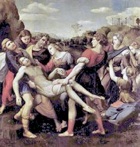
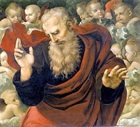
The putative upper panel was documented in various locations after the dismemberment of the altarpiece in 1608:
-
✴Giovanni Francesco Morelli saw it above the high altar of the Oratorio di San Bernardino in 1683. It was in a reconstruction of the original work that also included a copy (1609) of the main panel that is attributed to Giuseppe Cesari, il Cavalier d’ Arpino. He described this upper panel as a copy by Stefano Amadei.
-
✴Giuseppe Maria Modestini saw it above another altarpiece on the Altare del Presepio of San Francesco al Prato in 1787. He believed that it came from the original altarpiece by Raphael.
There is still no consensus on the status of the panel in the gallery. If it is indeed a copy, the location of the original is unknown. Scholars who deem it to be original concede that it is a workshop painting that follows Raphael’s design. (One such design, which is attributed to Raphael) survives in the Palais des Beaux Arts, Lille). Umberto Gnoli (referenced below) attributed it to Domenico Alfani. However, the gallery notes support the theory that it is a copy by Stefano Amadei.
Sapienza Vecchia Altarpiece (1518)
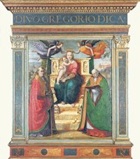
Holy Family (1520 or 1522?)
This panel, which came from the high altar of San Simone del Carmine, is attributed to Pompeo d' Anselmo and Domenico Alfani on the basis of an inscription that is not easy to interpret. This inscription also dates the panel to 1520 or 1522. The design of the central figure group is taken from the sketch (ca. 1507) mentioned above that Raphael sent to Domenico Alfani. This sketch is now in the Musée des Beaux Arts, Lille.
The panel was removed from its altar in 1813 for dispatch to Rome (probably because it was then attributed to Perugino). However, it was subsequently decided that it should stay in the church, and it was re-installed early in the following year. It entered the Galleria Nazionale in 1863 and now in deposit there.
The altarpiece depicts the Virgin seated in a landscape. The standing baby Jesus leans across her lap to take a pomegranate from St Joseph, who is seated nearby. The young St John the Baptist draws the viewer's attention to this act, which foreshadows the Passion. The Virgin's parents, SS Anne and Joachim stand to the sides. Putti play in the clouds, below the Holy Spirit represented as a dove.
Pietà (1522)
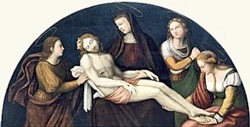
This lunette-shaped panel, which is signed by Domenico Alfani and dated by inscription, was described in the 19th century in Santa Maria Nuova, where it was displayed in the Altare dell’ Annunziata above a processional banner attributed to Nicolò Liberatore, l’ Alunno (Galleria Nazionale, Room 12). It was almost certainly commissioned for Santa Maria dei Servi, where it would have formed part of a larger altarpiece, the other panels of which no longer survive. It probably moved to Santa Maria Nuova in 1540, and entered the Galleria Nazionale in 1863.
Madonna and Child with saints (1524)
Severo di Paride Petrini commissioned this altarpiece, which is dated by inscription, from Domenico Alfani for his family chapel in the right wall of Sant’ Agostino. The final payment for the work was delayed until 1541. The altarpiece was removed from the chapel in 1799 church and passed to the Accademia di Belle Arti in 1810. It is now in the deposit of the Galleria Nazionale.
The altarpiece depicts the enthroned Madonna crowned by angels holding the hand of the standing, naked baby Jesus, with SS Peter, Paul, Nicholas of Bari and Lucy.
Adoration of the Magi (1528-34)
According to Giorgio Vasari, after his mistreatment in Rome, Rosso Fiorentino “escaped with difficulty to Perugia, where he was warmly welcomed and reclothed by the painter Domenico di Paride, for whom he drew the cartoon for a panel picture of the Magi, a very beautiful work, which is to be seen in the house of Domenico”. This design has been lost, but it is known by a copy (1574) by Cherubino Alberti that is now in the British Museum.
Domenico Alfani used the design for the main panel of an altarpiece for the high altar of Santa Maria delle Grazie, Castel Rigone: this commission was formally renewed in 1528 and completed in 1534. Unfortunately, the altarpiece has not survived, although it is known from a photograph.
Madonna and Child with saints (1532)
This altarpiece, which is signed by Domenico Alfani and dated by inscription, came from Santa Giuliana. Agostino Tofanelli, the Director of the Musei Capitolini took the altarpiece to Rome in 1811, and it was returned to the church in 1815. It was transferred to the Galleria Nazionale in 1863 and now in deposit there.
-
✴The main panel depicts the Madonna and Child enthroned with SS John the Baptist and Juliana.
-
✴The predella depicts scenes from the martyrdom of St Juliana.
Madonna and Child with saints (1535)
This detached fresco, which is attributed to Domenico Alfani [and dated by inscription ?], is in SS Stefano e Valentino (on the wall at the end of the left nave). It is in the form of a fictive altarpiece, and depicts the Madonna and Child with SS Valentine, Nicholas of Bari, Antony of Padua and Vincent Ferrer. Its original location is unknown, although the presence of St Valentine suggests that it came from San Valentino. The attribution, although well-founded on stylistic grounds, was made only in 1921.
Nativity with St Anne (1536)
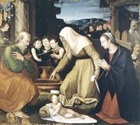
Adoration of the Magi (1545)
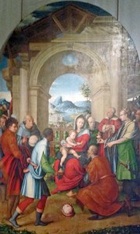
The work was subsequently split into two panels:
-
✴the Visitation; and
-
✴the Adoration of the Magi (illustrated here).
The predella, which had an inscription bearing the date, was subsequently lost.
The two main panels then went their separate ways:
-
✴Dominique-Vivant Denon, the Director of the Musée Napoleon selected the Visitation for confiscation after the Napoleonic suppression of 1810, and it is still in what is now the Musée du Louvre, Paris.
-
✴The Adoration of the Magi remained in Sant' Agostino until 1863, when it entered the Galleria Nazionale.
Crucifixion with saints (1553)
Pietro di Matteo commissioned this altarpiece in 1553 from Domenico and Orazio Alfani for his altar in San Francesco al Prato. Its wooden frame (now lost) was commissioned by the artists from Eusebio Bastoni. The altarpiece, which is usually attributed to to Orazio Alfani, depicts the Crucifixion with SS Jerome and Apollonia. It was removed from the church in 1863 and is now in the Galleria Nazionale.
Madonna and Child with saints (16th century)
This altarpiece is attributed to Domenico Alfani, came from San Francesco al Prato. It was one of three works in the church that Napoleon's commissioner, Jacques-Pierre Tinet selected for confiscation under the Treaty of Tolentino (1797). Antonio Canova recovered it in 1815 and it was returned to the church.
-
✴The main panel depicts the Madonna and Child with St Joseph and the young St John the Baptist, with SS Francis and Antony of Padua kneeling below. It was transferred to the Galleria Nazionale in 1863 and is now in the deposit.
-
✴The predella, which does not seem to have been sent to France, has been lost.
Adoration of the Shepherds (16th century)
The original provenance of this altarpiece, which is attributed to Domenico Alfani, is unknown. It is now the Galleria Nazionale.
Terni
Altarpieces (16th century)
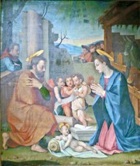
-
✴the Nativity (illustrated here); and
-
✴the Madonna and Child with saints and angels, which idepicts the Madonna and Child with SS Antony of Padua and Louis of Toulouse. Two angels hold a crown over the head of the Madonna, and the donor kneels to the left (not on display when I visited in June 2009).



